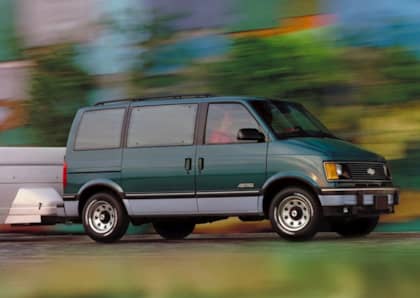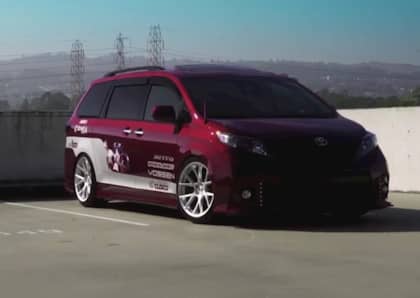5 High Performance Minivans You Didn't Know Existed
The idea of a high performance minivan might seem silly to some. After all, why take such a practical, stodgy vehicle and provide it with a heaping helping of horsepower and handling only to have it idle its way from the mall to lacrosse practice and then back home again every day of the week
And yet those same doubters wouldn't raise an eye at the long list of super-powered SUVs currently lurking on dealer lots, outfitted with hulking V8s and turbochargers, and featuring suspension setups more slalom-friendly than off-road oriented. Why can't minivans have their day in the sun, too?
Fortunately, there are a few vans out there that broke the mold when it come to providing an amazing driving experience alongside sports car-crushing straight line speed. Check out these 5 high performance minivans you didn't know existed.
1. Dodge Caravan Turbo
Chrysler was on a roll with its turbocharged four-cylinder engines in the 1980s, and it stuffed these potent power plants into an incredibly wide range of vehicles. Given that the Dodge Caravan minivan shared aspects of its platform with the vaunted K car (whose variants would elevate the Pentastar turbo to an art form), it was only natural that family buyers be given the option of forced induction, too.

In 1989 the Dodge Caravan Turbo debuted with a motor that squeezed 150hp and 180 lb-ft of torque from its modest 2.5-liters of displacement. While that might not sound like much, at the time it was a serious step up over the minivan's 100hp base motor, and it also provided an extra 45 lb-ft of twist to go with it. You could even get a long-wheelbase Plymouth Grand Voyager Turbo if your brand loyalties so dictated.

Even more exciting for fans of van turismo was the availability of a five-speed manual transmission. In stock form the Caravan Turbo could run the quarter mile in the mid-16 second range, and with a little tuning it was easy to knock a full second off of that time. Not bad in an era when automatic versions of the Ford Mustang 5.0 were posting mid-15 second runs at the drag strip.
2. Ford Supervan
Ford's Transit van was a legend in Europe well before it was every imported to America. Of course, its stellar reputation was based on its sheer practicality, not its ability to carve corners—that is until Ford decided to stir the pot with its series of Supervans, which date all the way back to 1971.

The original Supervan was built by Ford UK and took the squared-off Transit body shape and dropped it on a GT40 race chassis. This swapped cargo space for performance, plunking the race car's 5.0L, 435hp V8 behind the driver.

The second Supervan, creatively named Supervan 2, would repeat the process in the mid-80s by building a fiberglass Transit shell around a C100 Le Mans / FIA World Endurance Championship race car (complete with massive side scoops to feed its 590hp, 3.9-liter Cosworth V8, and an impressive array of spoilers).

The third (Supervan 3) appeared a decade later and went whole-hog on aero. Built on the same chassis as Supervan 2, it initially kept a Cosworth-sourced drivetrain (upgraded to 3.5L and 700hp), which it shared with a number of Formula One cars of the same era. Eventually, a more docile 260hp Cosworth V6 was swapped in to prevent would-be pilots from ending themselves on the track.
3. Toyota Sienna R-Tuned
The Toyota Sienna served as a SEMA palette for DG-Spec back in 2016, who were hired by the Japanese automaker to build a high performance minivan that would push the platform to its limits.

From a horsepower standpoint the R-Tuned Sienna was modest, featuring a little more than 300 ponies from its standard 3.5L V6.

The real difference lay in its reduced curb weight, with more than 800 lbs chopped out of its interior and body by way of carbon fiber body panels and a stripped interior. The van's lowered suspension was fully adjustable, and it rode on 18-inch wheels wrapped in Nitto NT01 tires.

Outfitted with a full cage, the van was intended to tackle a road course rather than a straight line, and its limited-slip front-differential and Carbotech brake pads helped it hook up and bleed off speed on corner entry and exit.
2. Mercedes-Benz R63 AMG
Mercedes-Benz built a minivan in the early 2000s and spent the entire time it was on sale insisting it didn't. Despite lacking a sliding side door the body shape of the R-Class was unmistakably van-like, and when the R63 AMG hit the streets it assumed the mantle of 'world's fastest production minivan' whether it liked it or not.

At the heart of the R63 AMG was a 6.2L V8 good for a whopping 507hp and 465 lb-ft of torque.

With standard all-wheel drive in the picture it only took 4.6 seconds to reach 60 mph from a standing start, and its upgraded suspension made a mockery of the body roll found on other more pedestrian vans of the era. Of course, owners had to deal with horrendous fuel consumption, sky-high repair costs, and the knowledge that you’d spent Porsche 911 money on a van, but that's the price of daring to be different.
1. Renault Espace F1
Ford wasn't the only automaker to stuff an F1 engine inside a minivan. In the mid-90s, perhaps inspired by the Supervan, Renault would bring the Espace F1 to the Paris Motor Show.

Featuring a 3.5L V10 mounted in the cargo bay, the hauler was capable of a ridiculous 194 mph top speed thanks to its 820hp and enormous roof-mounted wing.

Of course, those weren't the only differences between the Espace F1 and the standard version of the van, which was a family stalwart in Europe. The vehicle also featured a full carbon fiber body and chassis fabricated by Matra, which brought with it massive weight savings and made the Renault the world's lightest minivan at 1,300 lbs. The entire rear section of the vehicle was in fact a carbon copy of the previous year's Williams Formula One car, and carbon fiber brakes could be found at all four corners.
More From Driving Line
- Forgotten Mopar turbos: We’ve got the scoop on the quickest turbocharged Chryslers, Dodges, and more.











